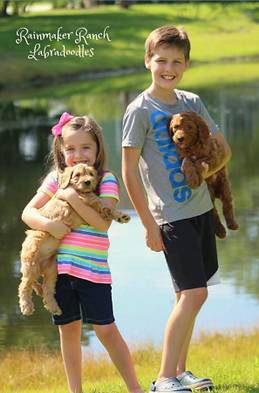top of page

Labradoodles and Kids
We specifically select our Australian Labradoodle puppies for each family based on two elements, one the family profile sent to you during the adoption process and two, puppy temperament testing, preformed with each puppy many times while they are in our care. Combining these elements to select the right dog is critical
Labradoodles and Kids: A Perfect Match—with
Preparation
Australian Labradoodles are known for their affectionate, intuitive nature, making them ideal family companions. But introducing a puppy into a home with children—especially young ones—requires preparation, patience, and the right match.

1. All Labradoodles are Not the Same
Temperament matters. While many Labradoodles are wonderful with children, some have higher energy or drive, which can be overwhelming in a household with young kids. That’s why we carefully match each puppy to your family using: .
● Your family profile
● Extensive temperament testing on each puppy in our care
Our goal is to place the right dog in the right home—not just any dog.
2. Generational Differences Matter
Some generations of Labradoodles are more suitable for families with children:
● F1 (First Generation): Higher drive, often harder to manage under age 2. Best for active families with older children.
● F1B (Second Generation): May show improved focus and lower drive, depending on breeding.
● Multigen Australian Labradoodles: Typically ideal for families with children due to their calmer, more adaptable temperaments.
Breeding for temperament is critical. Avoid breeders who pair dogs with anxious, aggressive, or
unsuitable temperaments—especially toy breeds prone to high anxiety.
3. Professional Training is Key
Especially with children involved, training isn’t optional:
● F1 (First Generation): Higher drive, often harder to manage under age 2. Best for active families with older children.
● F1B (Second Generation): May show improved focus and lower drive, depending on
breeding.
● Multigen Australian Labradoodles: Typically ideal for families with children due to their calmer, more adaptable temperaments.
We also offer a trained puppy option, where the puppy lives with our trainer from 8 to 12 weeks of age. This jumpstarts housebreaking, crate training, leash walking, and manners—but still requires your commitment at home.

4. Are You—and Your Kids—Ready?
Puppies mirror the environment they’re in. Ask yourself:
● Can your kids follow guidance around the puppy?
● Can you commit to at least 3 additional hours per day to supervise, train, and care for the puppy?
● Are you ready for 2 to 4 months of active involvement?
Puppy training is not child's play—it’s adult-led, consistent, and time-intensive.
5. How to Prepare Your Children (and Yourself)
To help your kids build a safe and loving relationship with your puppy:
● Supervise all interactions—never leave kids and puppies alone.
● Create structure: include “puppy time,” nap time, potty time, and kid-supervised playtime.
● Teach kids to be calm, avoid chasing, and never pick up the puppy without permission.
● Establish a puppy-only area for eating and sleeping.
● Use short leashes indoors to keep puppies close and avoid chaos.
Highly recommended reading:
● Raising Puppies and Kids Together – Pia Silvani & Lynn Eckhardt
● Happy Kids, Happy Dogs – Barbara Shumannfang
● Puppy Training for Kids – Sarah Whitehead

6. The First Month: What to Expect
The first month with your new puppy will be the most demanding. Create a written schedule
that includes:
● Wake-up time
● Potty breaks (with adult supervision)
● Meals
● Playtime (adult-supervised)
● Naps
● Training blocks
Post the schedule and follow it daily. Predictability helps both kids and puppies know what to
expect and when.
7. Socialization is Critical
Positive experiences shape your puppy’s future behavior. Aim for at least 50 positive
human interactions early on. Avoid overstimulating your puppy; instead:
● Introduce new people while holding the puppy close to your face
● Gradually expose them to various sights, sounds, and people
● Skip high-risk environments like dog parks or pet stores early on
Socialization builds confidence and reduces the risk of fear-based behaviors.
8. Set Clear Rules for Everyone
Kids and adults must know how to interact with the puppy safely:
● Wake-up time
● Potty breaks (with adult supervision)
● Meals
● Playtime (adult-supervised)
● Naps
● Training blocks

9. Labradoodles Are Family Dogs
Properly bred Australian Labradoodles are versatile companions. They can adapt to:
● Active families or more relaxed homes
● Playful kids or quiet environments
● Couch time or trail walks
But they are not outdoor dogs. They belong with you, inside your home, as part of the family.

10. A Lifelong Lesson in Responsibility and Love
Raising a Labradoodle puppy can teach children invaluable life lessons: patience, empathy,
responsibility, and unconditional love.
With time, effort, and structure, Labradoodles and kids form lasting bonds. In our home, our
dogs sleep with our children—even our 4-year-old. They share toys, listen to commands, and
love without condition.
Want More Guidance?
Visit our Training Page for schedules, example routines, and more expert advice on raising a
well-mannered Labradoodle puppy in a home with kids.

bottom of page
